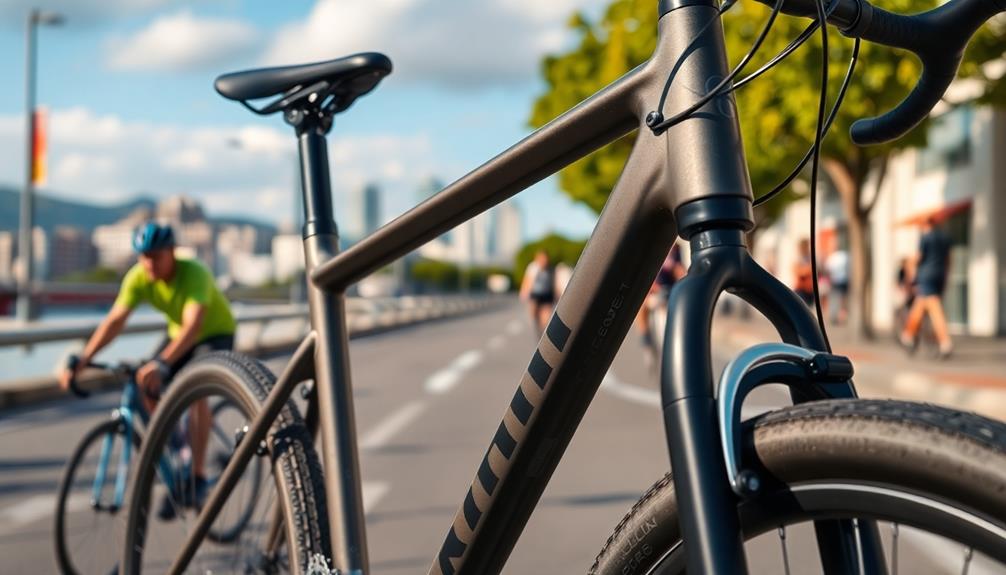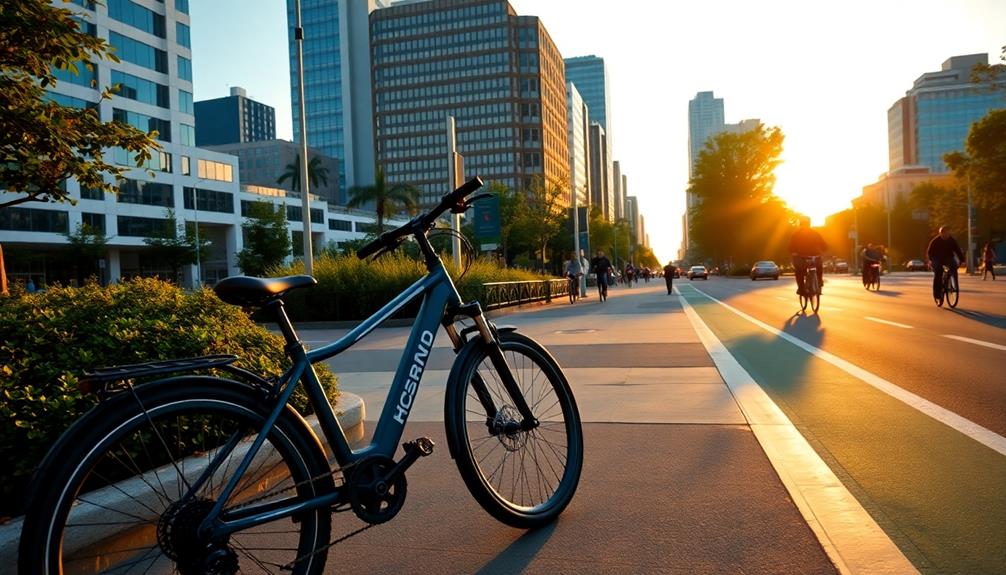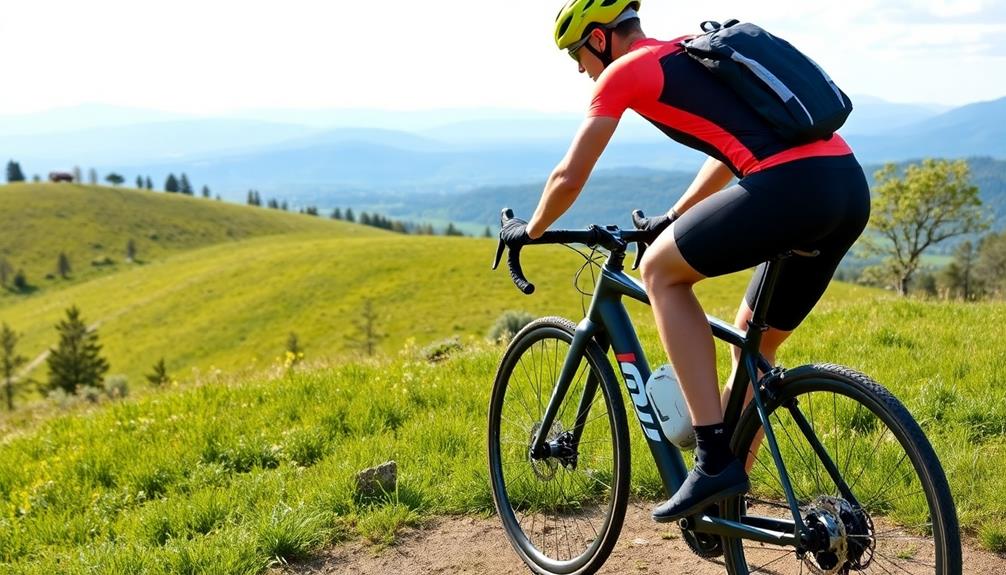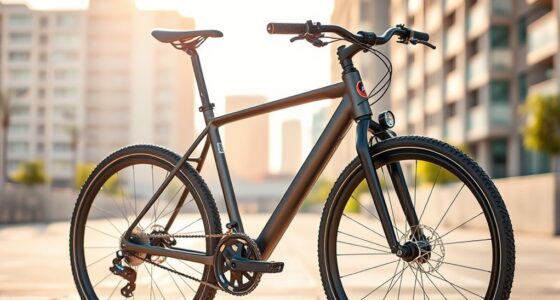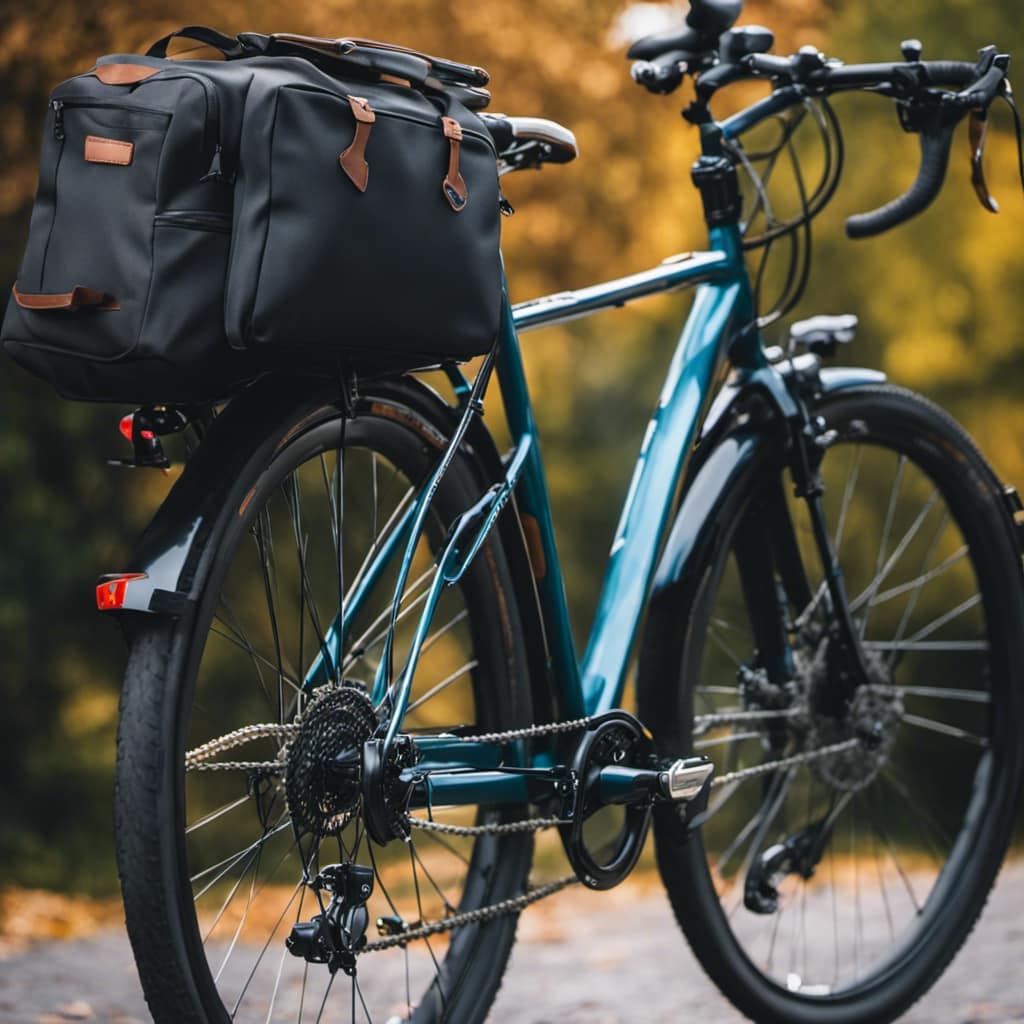Understanding hybrid bike geometry is essential for improving your ride. Geometry affects comfort, stability, and efficiency. Measurements like stack and reach influence how well the bike fits your body. A proper seat tube angle enables efficient pedaling, while wheelbase length impacts stability versus agility. A more relaxed frame design promotes an upright position, making longer rides more pleasant. Choosing the right geometry helps you navigate city streets with ease. By exploring further, you'll uncover additional insights on optimizing your bike choice for both comfort and performance.
Key Takeaways
- Hybrid bike geometry balances comfort and performance, ensuring an upright riding position for relaxed and efficient cycling.
- Key measurements like stack, reach, and seat tube angle influence overall fit, comfort, and pedaling efficiency.
- A moderate wheelbase provides stability for various terrains while enhancing maneuverability for city riding.
- Shorter chainstays improve agility, while longer chainstays offer stability, allowing for a versatile riding experience.
- Understanding personal fit relative to bike geometry is crucial for optimizing comfort and performance on a hybrid bike.
Importance of Geometry in Cycling
Geometry plays an essential role in cycling, impacting both your comfort and performance on the bike. Key measurements like stack and reach directly influence how well the bike fits you. A proper seat tube angle guarantees your position allows for efficient pedaling, enhancing your overall riding experience.
Understanding the versatility of hybrid bikes can help you appreciate how geometry affects performance across various terrains. The wheelbase length is important too; a longer wheelbase gives you stability, while a shorter one increases agility, which is critical for maneuvering varied terrains on a hybrid bike.
You'll find that a favorable head tube angle can make a significant difference in your steering responsiveness. A steeper angle allows for quicker turns, while a slacker angle provides more stability during descents.
Additionally, chainstay length plays a significant role in how your bike performs on climbs and accelerations. Shorter chainstays offer agility, which can be great for maneuvering, but they might compromise stability.
Key Geometry Measurements

When selecting a hybrid bike, understanding key geometry measurements is vital for achieving the best fit and performance. First, consider stack height, which measures the vertical distance from the bottom bracket to the top of the head tube. This influences your handlebar positioning and overall comfort during rides, similar to how Montessori toys promote comfort and creativity in children's play.
Next, look at reach, the horizontal distance from the bottom bracket to the head tube center; this plays a significant role in determining your fit and comfort on the bike.
The seat tube angle also affects your riding posture. A steeper angle promotes a more forward position, enhancing your pedaling efficiency, while a slacker angle allows for a more relaxed ride.
Additionally, pay attention to chainstay length; shorter chainstays enhance agility and responsiveness, while longer ones provide greater stability, especially on uneven terrain.
Lastly, the wheelbase, the distance between the front and rear axles, impacts overall bike stability. A longer wheelbase offers improved stability at speed, while a shorter one allows for quicker turns and agility.
Hybrid Bike Geometry Overview
Hybrid bike geometry strikes a balance between comfort and versatility, making it ideal for various riding conditions.
You'll notice key measurements like stack and reach that guarantee a relaxed posture while allowing efficient power transfer.
This design is particularly beneficial for changing gears on a gravel bike, as it promotes easy maneuverability, perfect for traversing city streets or enjoying longer rides.
Key Geometry Measurements
Finding the right fit on a bike can greatly enhance your riding experience, and understanding key geometry measurements is essential for that. Two critical factors are stack and reach. Stack refers to the vertical distance from the bottom bracket to the head tube top, while reach measures the horizontal distance. These dimensions help determine how comfortable you feel on your bike.
Additionally, considering your riding goals and preferences can aid in selecting the appropriate geometry for your needs, particularly when it comes to investment strategies that can enhance your overall biking experience.
Next, consider the seat tube angle, which typically ranges from 72 to 74 degrees. This angle influences your riding posture and pedaling efficiency; a steeper angle promotes a more forward position.
The head tube angle, often between 70 and 73 degrees, affects your bike's steering responsiveness. A steeper angle allows for quicker handling, while a slacker angle offers stability.
The wheelbase, usually between 1000mm and 1050mm, also plays a role in stability and ride comfort, with longer wheelbases providing a smoother experience.
Balance of Comfort
Comfort is often a top priority for riders selecting a hybrid bike, and the geometry plays an important role in achieving that. Hybrid bikes typically feature a relaxed frame design that promotes an upright position, making your rides more enjoyable, whether you're commuting or exploring.
The combination of shorter reach measurements and higher stack allows for easier handling and control, which is vital in urban settings and light off-road trails. Additionally, just as modern heat pump systems prioritize user comfort with quieter operation, a well-designed hybrid bike geometry contributes to a smoother ride experience. Enhanced ventilation helps maintain comfortable environments.
The wider tires and moderate wheelbase offer increased stability and balance, boosting your confidence on varied terrains. With flat handlebars included in the geometry, you get better leverage and control, greatly reducing strain on your back and shoulders. This design aspect enhances comfort, especially during longer rides.
Furthermore, the steeper seat tube angle helps maintain an efficient pedaling power while ensuring a comfortable riding posture. This balance of comfort and performance makes hybrid bikes a versatile choice for diverse riding conditions.
Ultimately, by understanding how geometry affects comfort, you can make a more informed decision when selecting your perfect hybrid bike.
Versatility for Riders
The geometry of hybrid bikes makes them incredibly versatile for riders of all kinds. This unique design combines the upright seating position of mountain bikes with the speed-oriented features of road bikes, guaranteeing comfort and visibility.
With a hybrid bike, you can effortlessly shift between different riding environments, much like the benefits of the best heat pump systems for maintaining comfort in varying weather conditions optimal comfort in varying weather conditions.
Here's how its geometry enhances versatility:
- Maneuverability: The shorter wheelbase and slacker head tube angle allow for easy navigation in urban settings and tight spaces.
- Stability: Longer chainstay lengths improve stability and comfort on varied terrains, making your ride smoother.
- Riding Position: The moderate bottom bracket height balances pedal efficiency and stability, especially during cornering or on uneven surfaces.
- Effective Top Tube: Designed to accommodate diverse rider heights, the effective top tube guarantees a comfortable riding posture for both leisurely outings and longer commutes.
Comparing Different Bike Types

When you compare hybrid bikes to road and mountain bikes, you'll notice some key differences in their design and performance.
Road bikes prioritize speed and efficiency with a lower, more aerodynamic position, while mountain bikes are built for rugged terrains and stability.
Hybrid bikes blend these features, offering a comfortable ride that's perfect for daily commutes and casual outings.
This versatility can parallel the importance of nutrition for brain development, emphasizing how a balanced approach can enhance overall performance in both biking and child growth.
Road Bike Characteristics
Here are four key characteristics of road bikes that set them apart:
- Seat Tube Angle: Road bikes usually have an aggressive seat tube angle (around 73-75 degrees), promoting a forward riding position. This enhances aerodynamics and power transfer, especially during climbs, making them a preferred choice for those looking to optimize performance in their rides and ensuring they effectively tackle various terrains, similar to addressing common technical SEO issues.
- Bottom Bracket: A lower bottom bracket height offers a reduced center of gravity. This improves cornering performance and minimizes pedal strikes, giving you confidence in turns.
- Wheelbase: Road bikes generally have a shorter wheelbase, enhancing agility for easier maneuvering. However, this can compromise stability at high speeds or on rough surfaces.
- Handling: With a steep head tube angle (around 72-74 degrees), road bikes provide quick handling and responsive steering, ideal for cyclists who thrive on speed.
Mountain Bike Features
Understanding the differences in bike geometry can help you choose the right ride for your needs. Mountain bikes are designed for rugged terrains, featuring a geometry that prioritizes handling and stability. This means you get a more aggressive riding position, which can be less comfortable for casual rides.
However, if you're tackling steep trails or rocky paths, that geometry is critical. Additionally, just like the importance of robust contingency plans during a Microsoft Outage Impact, choosing the right bike geometry can greatly affect your riding experience.
When comparing hybrid bikes to mountain bikes, you'll notice hybrids often incorporate features like front suspension. This front suspension absorbs shocks, similar to mountain bikes, providing a smoother ride over bumps.
Additionally, hybrids typically have shorter chainstays, enhancing maneuverability and responsiveness, making them easier to handle in urban settings.
While mountain bikes excel on rough trails, hybrids offer an upright riding position, blending comfort with the capability to traverse varied terrains. The relaxed head tube angle found in hybrids improves handling and stability, especially on uneven surfaces.
If you're looking for a versatile bike that strikes a balance between comfort and performance, understanding these mountain bike features in the context of hybrid options can guide your decision.
Reading and Understanding Geometry Charts

Often, geometry charts can seem overwhelming at first glance, but they're vital for selecting the right hybrid bike. A well-maintained bike can greatly enhance your riding experience, much like how a clean home promotes health and wellness benefits.
Understanding the key measurements will help you find a bike that fits your needs and enhances your riding experience. Here are four important aspects to pay attention to:
- Top Tube Length: This affects your reach to the handlebars, impacting comfort and control.
- Seat Tube Angle: A steeper angle generally promotes a more efficient pedaling position, ideal for climbing.
- Head Tube Angle: This influences steering responsiveness; a steeper angle offers quicker handling, while a shallower angle provides stability.
- Chainstay Length: Shorter chainstays enhance agility, making it easier to maneuver, whereas longer chainstays lend more stability during rides.
Additionally, don't overlook the reach and stack measurements. These numbers indicate how the bike fits various body types and riding styles.
Comparing geometry charts across different hybrid bike models enables you to make informed decisions, ensuring you select a bike that matches your riding preferences and comfort needs.
Understanding these elements can considerably enhance your biking experience.
Common Misunderstandings About Geometry

You might think that a longer top tube guarantees more comfort, but comfort actually hinges on your unique body proportions and riding style.
In fact, finding the right fit for your bike can have similar benefits to creating an organized environment, as it enhances your overall experience and promotes a sense of calm while riding.
It's easy to assume all mountain bikes have a standard geometry, yet they vary considerably to suit different terrains and preferences.
Plus, don't let price fool you; the best geometry for you depends on your specific riding goals, not just the cost of the bike.
reducing stress levels can greatly improve your connection with the ride.
Geometry Equals Comfort Misconception
Many cyclists fall into the trap of believing that longer top tubes automatically equate to better comfort, but the reality is far more nuanced. Comfort on a hybrid bike is influenced by several factors that extend beyond mere geometry.
Here are four key elements to take into account:
- Torso Length: Your torso length greatly impacts how you fit on the bike, affecting your reach and overall comfort.
- Arm Length: Similar to torso length, your arm length plays a vital role in how you interact with the handlebars and the bike's geometry.
- Bike Fit: Proper bike fit is essential; even the best geometry won't save you from discomfort if the bike isn't tailored to your body.
- Handling Characteristics: Different hybrid bike geometries affect handling, so what feels comfortable for one rider may not feel the same for another.
Understanding these factors can help you make informed decisions about bike fit and geometry.
One Size Fits All
The idea that "one size fits all" when it comes to bike geometry is a significant misunderstanding that can lead to discomfort and poor performance. Your body type plays a vital role in how a bike fits you. Key measurements like reach and stack are essential for ensuring that you're comfortable while riding. If you overlook these factors, you might end up with a bike that doesn't suit your needs.
Many riders mistakenly believe all hybrid bikes have the same geometry, but significant variations exist that can affect your handling and stability. For instance, the effective top tube length can make or break your ride. A longer top tube isn't always better; it depends on your torso and arm lengths.
Also, it's a misconception that geometry adjustments are fixed. You can fine-tune your fit by adjusting the stem length, saddle position, and handlebar height to achieve a personalized experience.
Understanding that bike geometry isn't one-size-fits-all will help you find the perfect fit, enhancing both your comfort and performance on the road.
Price vs. Geometry Accuracy
While it's easy to assume that a higher price tag guarantees better bike geometry, this belief can mislead riders into making poor choices.
In reality, geometry is tailored to specific riding styles, so a less expensive bike might be a better fit for you. Here are four key points to take into account:
- Geometry Variation: Prices don't always reflect the geometry; bikes at different price points can feel vastly different when riding.
- Personal Fit: Your body type and riding style matter more than the price; a bike that fits you well will enhance your comfort and performance.
- Adjustments: You can often achieve ideal geometry through simple adjustments and accessories, making high costs unnecessary.
- Test Rides: Always test ride multiple bikes to evaluate geometry. This hands-on experience is essential in finding the right fit for your unique needs.
Understanding that geometry can't be judged solely by price emphasizes how important it's to prioritize personal fit and comfort.
Effects of Geometry on Ride Comfort

In exploring hybrid bike geometry, you'll find that various measurements greatly impact ride comfort. The top tube length plays an essential role; a longer top tube can stretch you out for speed, while a shorter one allows for a more upright position, enhancing visibility and comfort during leisurely rides.
The seat tube angle also affects your posture relative to the pedals. A steeper angle may boost your pedaling efficiency, whereas a more relaxed angle promotes a comfortable seating position for longer journeys.
Additionally, stack and reach measurements determine your handlebar height and saddle position, impacting your overall comfort. A higher stack with a shorter reach is ideal for those with longer torsos, ensuring comfort on extended rides.
Chainstay length affects stability and responsiveness; shorter chainstays provide agility, making the bike feel more maneuverable, while longer ones improve stability over rough terrain.
Finally, wheelbase length is essential for ride comfort; a longer wheelbase absorbs bumps better and enhances stability, whereas a shorter wheelbase offers agility for steering through tight spaces.
Understanding these geometric factors helps you select a hybrid bike that aligns with your riding style and comfort needs.
Advanced Geometry Elements

Advanced geometry elements in hybrid bikes, like fork rake and trail, play a significant role in how your bike handles various terrains. Understanding these elements can help you make an informed choice when selecting the right bike for your needs.
Here are key factors to evaluate:
- Fork Rake: A larger fork rake enhances stability but may reduce turning responsiveness, impacting your handling characteristics in tight corners.
- Wheelbase: Longer wheelbases provide steadiness on smooth surfaces, while shorter ones allow for quicker maneuvers in urban environments.
- Chainstay Length: Shorter chainstays improve agility and responsiveness, making them great for climbing, while longer ones add stability and comfort during rides.
- Bottom Bracket Height: A higher bottom bracket gives you better obstacle clearance but can compromise stability. In contrast, a lower height enhances agility in turns.
Practical Applications for Riders

When choosing a hybrid bike, understanding its geometry can greatly enhance your riding experience. The relaxed frame design typically promotes an upright riding position, which not only boosts comfort but also improves visibility during urban commutes.
If you're maneuvering through city traffic, look for a bike with a shorter wheelbase; this will enhance maneuverability, allowing you to navigate tight turns with ease.
Pay attention to the seat tube angle and bottom bracket height as well. These elements can considerably impact your pedaling efficiency, especially on longer rides or steep climbs. A well-optimized setup can make a big difference in performance and comfort.
Additionally, consider the chainstay length. Shorter chainstays can improve heel clearance and rear stability, which is crucial if you plan on tackling light off-road trails.
Ultimately, understanding how these geometric features affect your riding position and bike handling will help you choose a hybrid bike that aligns perfectly with your cycling style, whether it's for casual commuting or adventurous rides on varied terrains.
Resources for Further Learning

To dive deeper into hybrid bike geometry, you can tap into a wealth of online resources that offer valuable insights. Understanding how stack, reach, seat tube angle, and head tube angle affect your ride is essential for achieving the perfect bike fit.
Here are some resources to take into account:
- Bike Insights: This site lets you compare different hybrid bike geometries, focusing on stack and reach for tailored riding experiences.
- Geometry Geeks: Explore and analyze various geometries, helping you find the best fit for your body type.
- Sizing Charts: Check out manufacturer sizing charts to see how frame sizes influence your riding experience and comfort.
- Online Forums: Engage in discussions with experienced riders who share insights on how bike geometry impacts handling and stability in various conditions.
Additionally, think about reading books or watching videos on bike fitting techniques. These often provide valuable information on adjusting your bike's geometry to enhance comfort and performance.
Frequently Asked Questions
How Does Bike Geometry Affect Ride?
Bike geometry affects your ride by influencing comfort, stability, and handling. A well-designed bike guarantees you enjoy a smoother experience, making it easier to navigate urban environments and tackle various terrains without compromising performance.
Does Bike Geometry Affect Speed?
Bike geometry's like a dance partner; it can lead you to speed or slow your rhythm. When you ride, you'll notice that a bike's shape and angles directly impact how fast you can go.
What Makes Bike Geometry More Aggressive?
Aggressive bike geometry's defined by shorter reaches, steeper seat tube angles, and lower stack heights. These features promote a forward-leaning position, improve aerodynamics, enhance maneuverability, and boost handling, making your ride faster and more responsive.
Does Bike Geometry Affect Climbing?
Yes, bike geometry considerably affects climbing. A steeper seat tube angle, lower bottom bracket, and shorter chainstays improve your power transfer and stability, making it easier for you to tackle steep inclines efficiently and comfortably.
Conclusion
To conclude, savvy cyclists should seriously consider how geometry influences their ride. Grasping the guidelines of hybrid bike geometry can greatly enhance your cycling experience, making every journey more enjoyable. Whether you're seeking speed or comfort, understanding these essential elements empowers you to choose the perfect bike for your needs. So, saddle up, stay informed, and set off on your cycling adventure with confidence! Happy riding!
